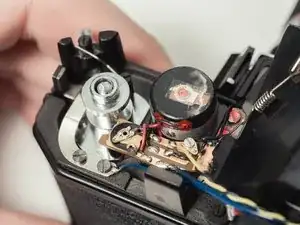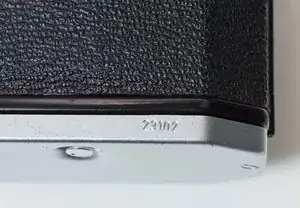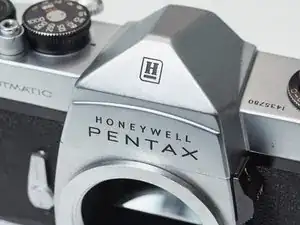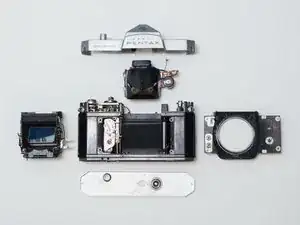
Pentax Spotmatic Light Meter Calibration
These are some common tools used to work on this device. You might not need every tool for every procedure.
The Pentax Spotmatic was the first camera released by Asahi Optical Company with through-the-lens metering, a big advancement in camera technology for the era. The camera uses stop down metering, which means that the lens aperture needs to be closed down to the selected value for a meter reading to be taken and the proper exposure calculated. A switch on the side of the lens mount turns on the meter and stops down the aperture. Later cameras, like the Spotmatic F, were capable of open aperture metering when combined with Super-Multi-Coated Takumar lenses.


The Spotmatic was manufactured from 1964 to 1973 and saw many small modifications throughout that time. The guides found here were written for models with a part number of 23102, the most common version. Early Spotmatics, built between 1964 and 1965, have a part number of 231. The overall structure of the camera is the same but there may be differences in individual parts here and there. The guides are applicable to both Asahi Optical Company (AOC) Spotmatics and Honeywell Spotmatics. Other similar models such as the SP500, SP1000 and SP II can also be repaired with these guides, but some differences will need to be accounted for. Even the Pentax K1000 has the same basic architecture as the Spotmatic and can be repaired with some of the same guides. Electronic models like the Electro Spotmatic, ES, and ES II are fundamentally different cameras that require their own methods.
The operation of the camera, including the timing of the shutter speeds, is fully mechanical. The battery is only required for the light meter, but normal exposures can be made without any power. Consequently, most malfunctions are due to dirty or fouled mechanisms. Disassembling, cleaning and reassembling the affected area will resolve most issues with the camera. Occasionally, replacement parts will be needed, but the individual components are quite robust and most can be refurbished.
The general procedure for troubleshooting major faults and malfunctions is to disassemble the camera into its primary subassemblies and inspect each to see if it is functioning normally. For the Spotmatic, and most 35mm SLRs, the major subassemblies and the functions they perform are as follows.

The most common issue is simply a jammed camera. The shutter won't fire and/or the film advance won't wind. The release sequence of a mechanical camera is quite complex and if any latch or lever is not functioning properly, it can result in an incomplete exposure cycle and a jammed camera. The high level solution is to disassemble the camera and inspect the different mechanical subassemblies until the root cause is identified. The most common areas to find issues are on the bottom of the camera and on the side of the mirror box. Disassembling and cleaning the mechanisms can return most jammed cameras to functionality.
Inoperable meters are also common. This is usually caused by corroded battery contacts or bad internal wiring, which are repairable. Sometimes the light sensitive resistors (CdS cells) can fail, which requires a replacement part.
Exposure variation within the frame is another common problem. Over time, the speed of the shutter curtains can drift causing them to become out of sync. At high speeds, the curtains must be very precisely timed in order to create a narrow slit that travels over the film. If one curtain is too fast or too slow, the slit can collapse resulting in little or no exposure on that part of the frame. While the adjustment points for curtain speed and release timing are easily accessible, making changes is not recommended without advanced equipment that can accurately measure the speed and exposure time of the shutter. Additionally, extreme exposure variation is a sign of a dirty shutter and it's best to disassemble and clean it before making adjustments to ensure good long term performance of the camera.
If you are already performing significant disassembly of the camera for a repair, consider doing a more complete overhaul of the camera to reduce the chance of future issues. The following service will address the most common failure points of the Pentax Spotmatic.
See the Pentax Spotmatic Troubleshooting page.